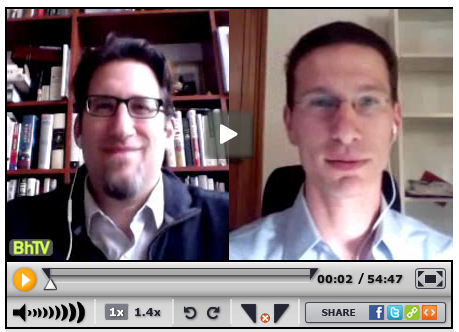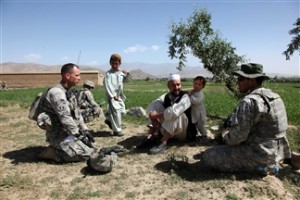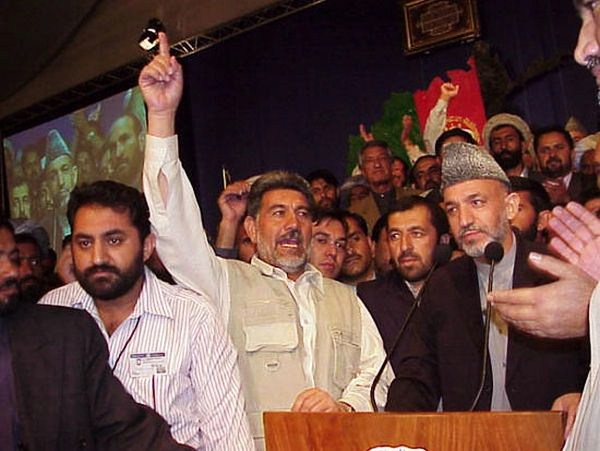Review of Rod Nordland’s The Lovers
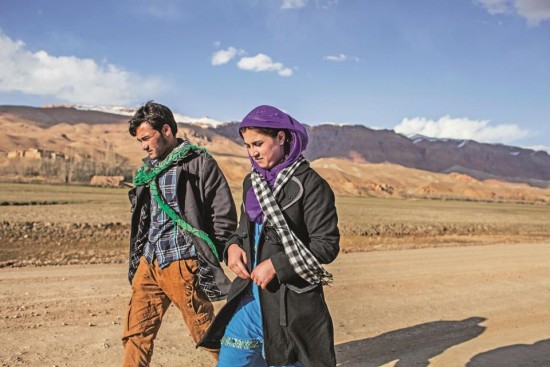
Zakia and Ali. Photo: DIEGO IBARRA SANCHEZ
[Book review in The Boston Globe.]
When news reached Kabul that a pair of teenagers was breaking every manner of taboo, determined to marry for love or else die in rural Bamian province, New York Times reporter Rod Nordland jumped. He had been looking for just such a story to illustrate Afghanistan’s horrifying tradition of rape and “honor killings,” as well as the courage of young people ready to challenge the old system.
Zakia and Ali had met as children — their families farmed neighboring plots — and decided when they came of age to defy their parents and marry. By the time Nordland meets them, Zakia is hiding in a women’s shelter. Her family is threatening to kill her because she has tarnished their “honor.’’
Their story makes sensational headlines about “Afghanistan’s Romeo and Juliet,” and Nordland doggedly sticks with the protagonists. The result is “The Lovers,” a rich account of Zakia and Ali’s romance that doubles as an indictment of the Afghan patriarchy’s abuse of women and the failures of all those in power, inside and outside the country, to curtail it.
Nordland follows the couple’s escape into the mountains, their marriage and honeymoon on the run, and the hair-raising manhunt that pits Zakia’s relatives against the bride, groom, and his family. Along the way a circus of Afghan and US government officials and international gadflies try to shape the fate of Zakia and Ali.
Couples like Zakia and Ali usually pay for their daring with their lives. This exceptional pair, however, doubles down on their decision to marry by going public with their tale. Miraculously, they manage to avoid being killed, although their victory seems pyrrhic. Some young Afghans find solace in the couple’s crusade, although we only learn of their social resonance in glancing references to their celebrity status.
What support the couple wins from local power brokers has more to do with ethnic and tribal loyalty than any major change of heart among patriarchal elders. Zakia and Ali enjoy what pass for moments of serenity on the lam from vengeful relatives, discovering that the married life for which they fought so gallantly includes long stretches of monotony and bickering.
For Americans contemplating their longest war, in Afghanistan, the campaign for women’s rights was a potential bright spot. The 2001 invasion might have failed on most counts, mired in torture, warlordism, and corruption, but at least the appalling position of women was supposed to improve.
Nordland’s “The Lovers” fatally complicates that optimistic narrative. In the 1980s, when Nordland first covered the conflict in Afghanistan, the United States supported mujahedeen whose main motivation to fight was to reverse the Soviets’ emancipation of Afghan women. So it was rich with irony that after the United States staged its invasion, it pushed for a flurry of women’s rights laws that improved things mainly on paper — and were undermined by the same warlords who owed their rise to American patronage.
To contextualize Ali and Zakia’s romantic yarn, Nordland presents a tirade of stories of rape, murder, bribery, and cover-up. While this barrage of anecdotes enrages, it does not advance our understanding of the thinking of the men who run this brutal system. Nor does it explain how they secure the cooperation of their countrymen.
Ali and Zakia are simple characters, illiterate, uneducated, and young. Although they star in this account, we never fully understand why they took such a bold leap. The closest glimpse we get to their souls is through the poetic verses that Ali selects for his cellphone ringtone.
There’s another story here, which Nordland shares with admirable candor and unflinching honesty, and that is of the unsatisfying, at times distressing, encounter between Afghans and the foreigners who have come to save, subjugate, or chronicle their country.
Almost from the first, Nordland dispenses with sanctimony. Journalists are supposed to maintain objectivity and avoid becoming part of the story. But in war zones, lines get blurred, and Nordland refuses to ignore his responsibility to be humane and help his subjects.
He gives Zakia and Ali money, lobbies for them with government officials, arranges a getaway car, and choreographs one abortive flight abroad.
The couple proves maddening and headstrong. They routinely ignore advice, dodge phone calls, and surface only when they need help or money. They might frustrate their allies, but Nordland respects their agency and independence of thought. They might not make the wisest choices, but the point is they act empowered in a society where few do.
The American government offers little aid, seeming reluctant to grant asylum to persecuted Afghans because it would undermine the line that Afghan women are better off since the Americans came.
All the more reason to chronicle this bittersweet, ambiguous love story. Zakia and Ali haven’t changed the status of Afghan women, and Nordland’s relentless reporting hasn’t shifted US policy. But the very acts of successful resistance and honest storytelling provide much-needed seeds of hope.
THE LOVERS: Afghanistan’s Romeo and Juliet, the True Story of How They Defied Their Families and Escaped an Honor Killing
By Rod Nordland
Ecco, 384 pp., $26.99
Thanassis Cambanis writes The Internationalist column for Globe Ideas and is a fellow at The Century Foundation in New York. His most recent book is “Once Upon a Revolution: An Egyptian Story.’’
Cambanis vs. Cohen on Bloggingheads
My first foray onto Bloggingheads TV, with fellow TCF fellow Michael Cohen. Michael thinks COIN is “claptrap”; I think it was a decent idea taken too far. We’re both starting our discussion with a read of Fred Kaplan’s book The Insurgents, and our own long-standing argument about what went wrong in Iraq (and our mostly shared view of what went wrong in Afghanistan).
If you watch, you can hear in the background my kids apparently trying to tear down our house, directly upstairs from my head.
BONUS: CROWD-SOURCED TECH HELP? For some reason, I can’t figure out how to embed the video here. When I paste the embed code from BhTV in the post on WordPress, it just leaves the code as is. Any suggestions?
<embed type=”application/x-shockwave-flash” src=”http://static.bloggingheads.tv/ramon/_live/players/player_v5.2-licensed.swf” flashvars=”diavlogid=15077&file=http://bloggingheads.tv/playlist.php/15077/00:00/54:47&config=http://static.bloggingheads.tv/ramon/_live/files/2012/offsite_config.xml&topics=false” height=”288″ width=”380″ allowscriptaccess=”always” id=”bhtv15077″ name=”bhtv15077″></embed>
Kaplan and COIN: The Tweets
Fred Kaplan graciously took part in a Twitter conversation about his book, The Insurgents. He explained his concerns that the military remains confused about its mission, and expounded on his view that counterinsurgency doctrine is sometimes the right recipe and is not, as I suggested in a question, “snake oil,” or “the best way to fight a kind of war we should never fight.”
The tweets have been gathered here in what to the horror of those who care about grammar, is called a “storify,” v. trans. “to storify.”
Arrested Development: The Pentagon Going Forward
The Pentagon finally learned to embrace new ideas. Can its short-lived revolution in thinking survive the coming period of austerity and retrenchment? [Originally posted on The Blog of the Century.]
The American military has maintained global dominance in part by being all things to all people. Blessed with a Brobdingnagian budget, it has been able to prepare for all kinds of war, all at the same time. Faced now with cuts after a decade of open-handed war funding, the Pentagon has raised the alarm about readiness. The Joint Chiefs of Staff in a unanimous letter in January complained to the president that “we are on the brink of creating a hollow force.”
The debate over the size and mission of the military often obsesses about questions of degree: should the United States be able to fight two major wars at the same time? Should it design a force that can fight many small wars?
But this debate, driven by budget-hungry service chiefs and tradition-hemmed academics and think-tankers, might be ignoring a far more important turning point facing the Pentagon today, which has more to do with mindset than money. Can the Pentagon retain the one truly good thing it acquired along the way in the bungled war on terror, Afghanistan, and Iraq—a possibly short-lived ability to learn?
Fred Kaplan’s new book, The Insurgents: David Petraeus and the Plot to Change the American Way of War, which I reviewed in the New York Times this Sunday, chronicles a chilling intellectual history of the officers who promoted counterinsurgency doctrine and eventually forced change among the Pentagon’s top brass. Kaplan is a skeptic, but his story reveals just how deeply hidebound the generals are, and how they were forced—through failure—to criticize themselves and adjust tactics.
Can this new mindset take root and become part of the Pentagon’s DNA, or is it destined to vanish as the generals who briefly dallied with self-awareness and adaptation now retrench around the common cause of budgetary self-preservation?
Listening to the current chairman of the Joint Chiefs of Staff, General Martin Dempsey, isn’t reassuring. Half a decade ago in Baghdad he eschewed BS, acknowledging the burgeoning failure and once telling a group of us reporters bluntly that “there isn’t enough concrete in the hemisphere to make Baghdad safe.” Now he’s stumping for wild defense budgets based on a spurious claim that the world is more dangerous than ever before and that we face an infinite menu of threats. Dempsey’s about-face doesn’t bode well.
For all the pitfalls of the war on terror, a decade of coalition-building and counterinsurgency forced the military to adapt and open itself up to new methods with an alacrity not seen since World War II. It was a wrenching internal fight between rigid generals, abstract bureaucrats, and junior officers open to experimentation and self-criticism, which Kaplan documents in vivid detail.
In The Insurgents (published in January), Kaplan argues that the U.S. military, perhaps inadvertently, discovered on the battlefields of Iraq and Afghanistan a new ability to learn. Now that the United States has moved away from those wars, Kaplan says, it is also throwing out what might be their only good legacy: imagination and flexibility in the Pentagon’s upper reaches.
His argument comes at a crucial time. President Obama last year ordered the Pentagon to cut off its budget for nation-building and long-term occupations of foreign lands—but he also instructed it to preserve the lessons it learned fighting counterinsurgencies in the Middle East. Many of the young officers who created a vogue around counterinsurgency in military circles grew just as dogmatic in their thinking as the older bureaucrats and officers who at first resisted new thinking, a sad process evident to any close observer of the slow failure of U.S. efforts in Afghanistan.
But they succeeded—at least in the last few years—at changing the military’s internal culture in ways far more consequential than the line item for a new bomber. They convinced the Pentagon to promote top generals who excelled in combat rather than those who had dutifully served in logistics and office posts. They reinvigorated the intellectual centers of military thinking, in particular the web of institutions from Fort Leavenworth to West Point that educate officers, write the military’s doctrine, and drive much of America’s strategic thinking. And they injected a strain of strikingly inventive utilitarianism—whatever works—into a vast defense bureaucracy that’s designed to protect fiefdoms rather than create new ideas.
Now, with the bloated war budgets ending and sequestration in site, a clear war of ideas is underway in the Pentagon: the old way, exemplified in the joint chiefs’ demand for big budgets, big weapons systems, and the same old lack of priorities, versus a fledgling new can-do culture that values the military’s ability to learn and adapt over its arsenal and size.
Let’s hope that creativity wins out. But I wouldn’t bet on it.
UPDATE: I debate The Insurgents and post-invasion Iraq with TCF fellow Michael Cohen. We’ll be on Bloggingheads TV on Wednesday.
How We Fight

Fred Kaplan’s Insurgents on David Petraeus
The American occupation of Iraq in its early years was a swamp of incompetence and self-delusion. The tales of hubris and reality-denial have already passed into folklore. Recent college graduates were tasked with rigging up a Western-style government. Some renegade military units blasted away at what they called “anti-Iraq Forces,” spurring an inchoate insurgency. Early on, Washington hailed the mess a glorious “mission accomplished.” Meanwhile, a “forgotten war” simmered to the east in Afghanistan. By the low standards of the time, common sense passed for great wisdom. Any American military officer willing to criticize his own tactics and question the viability of the mission brought a welcome breath of fresh air.
Most alarming was the atmosphere of intellectual dishonesty that swirled through the highest levels of America’s war on terror. The Pentagon banned American officers from using the word “insurgency” to describe the nationalist Iraqis who were killing them. The White House decided that if it refused to plan for an occupation, somehow the United States would slide off the hook for running Iraq. Ideas mattered, and many of the most egregious foul-ups of the era stemmed from abstract theories mindlessly applied to the real world.
There is no one better equipped to tell the story of those ideas — and their often hair-raising consequences — than Fred Kaplan, a rare combination of defense intellectual and pugnacious reporter. Kaplan writes Slate’s War Stories column, a must-read in security circles. He brings genuine expertise to his fine storytelling, with a doctorate from M.I.T., a government career in defense policy in the 1970s and three decades as a journalist. Kaplan knows the military world inside and out; better still, he has historical perspective. With “The Insurgents: David Petraeus and the Plot to Change the American Way of War,” he has written an authoritative, gripping and somewhat terrifying account of how the American military approached two major wars in the combustible Islamic world. He tells how it was grudgingly forced to adapt; how it then overreached; and how it now appears determined to discard as much as possible of what it learned and revert to its old ways.
Read the rest in The New York Times [subscription required].
Team America’s New Boss
The McChrystal story really spiced up the week, and brought the Afghan war into a really clear focus. Matthew Yglesias wrote a fantastic short essay at The Daily Beast about what General David Petraeus needs to do to succeed. In the piece, Yglesias tackles two potent and related points. First, he gives voice to the counter-narrative about the Iraq surge, arguing that what Petraeus accomplished there wasn’t “victory” or a “secure Iraq” but a political triumph – lowering America’s expectations enough that Iraq’s disappointing progress would satisfy Washington and allow an exit. Second, Yglesias argues that Afghanistan is literally unwinnable, but could be another “success” if Petraeus can work the same magical concoction: great PR, political jujitsu, and competent war management.
As he says in summation:
Petraeus could be just the man to do for Obama what he did for Bush: help reframe the problem and walk away from unrealistic goals while projecting determination and making things better in some small concrete ways.
Can Stan McChrystal’s Campaign Be Saved?
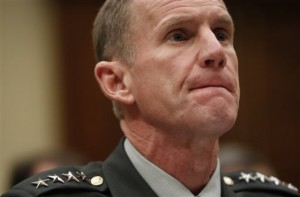 The nail-biting saga of General Stanley McChrystal’s Rolling Stone interview has riveted a wide audience whose interest in Afghanistan had otherwise flagged. Shortly we’ll know whether he keeps his job, and the hyperventilating will subside over civil-military relations (On life support? Healthier than ever?).
The nail-biting saga of General Stanley McChrystal’s Rolling Stone interview has riveted a wide audience whose interest in Afghanistan had otherwise flagged. Shortly we’ll know whether he keeps his job, and the hyperventilating will subside over civil-military relations (On life support? Healthier than ever?).
McChrystal’s personality aside, however, the American government needs to figure out something much more urgent and important: Is his counterinsurgency campaign in Afghanistan working? Based on what we’ve learned in the last year, can it work at all?
President Obama hired McChrystal to turn around a war that had stagnated. He was chosen to execute a nimble counterinsurgency strategy, a campaign designed to stabilize Afghanistan and win popular support among Afghanis, harnessing military, political and economic policy.
The prior strategy wasn’t working – the Taliban had made a dramatic comeback in the years since the original invasion in 2001. Even the most vocal proponents of counterinsurgency doctrine cautioned that it had no guarantee of succeeding. To give counterinsurgency a fighting chance might require more troops, money and time than the United States was willing and able to give. (That caveat presaged some early advocates’ current view that there were never enough resources tasked to make a COIN campaign viable.)
Now the U.S. is a year into McChrystal’s plan: the halfway point to the summer of 2011 when the surge is supposed to end and American troop numbers will be reduced. So much has gone off script, however, that it raises questions about whether McChrystal’s blueprint still applies.
- President Hamid Karzai has broken ranks, frequently attacking his U.S. patrons in public.
- The Taliban has gotten stronger militarily.
- The first showcase offensive in Marjah has so far failed to stabilize the town or deny the Taliban sanctuary there.
- This summer’s major showcase offensive in Taliban-dominated Kandahar has been indefinitely postponed.
- Pakistan has derailed efforts to negotiate with the Taliban, even arresting the Taliban’s number-two when he held clandestine meetings with the United Nations.
All these events don’t prove that the U.S. can’t achieve its aims in Afghanistan – but that’s the conclusion to which they’re beginning to point. Counterinsurgency defines the toolkit the military brings to the fight; it doesn’t actually answer the question of what America should do.
Over the next year, if it hopes to establish some lasting stable order in Afghanistan, America will need a far greater unity of effort between its generals, its diplomats, its special envoys, and its friends in the Afghan and Pakistani governments. With or without McChrystal, the United States will have to make course corrections in Afghanistan as the war unfolds.
Quick briefing materials
Fred Kaplan at Slate argues that McChrystal and his loose-lipped team reveal a war effort spinning of control.
Leslie H. Gelb at The Daily Beast argues that the Democratic Party suffers from a permanent culture clash with the military.
Andrew Exum writes a thoughtful post about whether the assumptions behind the current strategy in Afghanistan still hold up. He also struggles with the implications of firing/not firing McChrystal in these two posts.
In the “Is History Repeating Itself?” department we have Rajiv Chandrasekaran’s post-mortem on the last general fired from running the Afghan year, just about a year ago.
And finally, the Michael Hastings article in Rolling Stone that kicked off the fuss, and which – the scandal aside – raises pointed questions about whether the counterinsurgency strategy in Afghanistan makes any sense.
The Afghanistan Endgame
Brian Katulis at the Center for American Progress and Andrew Exum at the Center for New American Security tangled this week over Afghanistan strategy. Brian said the counter-insurgency community had hoodwinked Washington, and Andrew said that the Center for American Progress hadn’t presented compelling plans for Iraq and Afghanistan. Michael Cohen prompted the kerfuffle when he argued that the left had failed to question the war in Afghanistan and propose credible alternatives.
All of which got me thinking: can the think tank community propel a smart, substance-focused public debate about America’s strategic aims in Afghanistan? I have in mind a probing, impolitic assessment of whether the current tactics can achieve that strategy. CAP invited CNAS to take part in a public debate, which Exum said he we would happily join after returning from a dissertation leave. But I’d like to see these thinkers applying their brains to the big sprawling questions. Think tanks are largely extensions of different power constituencies in Washington, so perhaps it’s naïve, or structurally impossible, to expect them to re-frame the Afghanistan debate so that it includes more than the current two options: leave, or stay and fight, with some debate over the timeline and number of troops.
I expected this kind of vigorous reappraisal in 2009, during the Obama Administration’s Afghanistan policy reviews. However, the government ended up focusing on narrow questions, like how many troops were required to execute a counter-insurgency strategy, and on what timeline American troops should withdraw. The public never heard an airing of the underlying strategic questions:
- What tactics have been most effective at killing, capturing or deterring individuals and organizations whose goal is to conduct terrorist attacks beyond Afghanistan’s borders?
- What is America’s desired end-state in Afghanistan and Pakistan? Is it achievable, especially considering Afghan President Hamid Karzai’s drift away from the U.S. and Pakistan’s internal problems?
- If not, can America disentangle itself from Afghanistan in its tenth year of war there, even without achieving its principal war aims?
- If the U.S. cannot midwife a stable Afghanistan (or Pakistan) then what is the most effective way to combat the international terrorist groups currently thriving in the borderlands of Afghanistan and Pakistan?
These questions are tough, and probing honest answers would probably require the defense and South Asia experts to jettison some of their previous conclusions and criticize the policies of some of their friends and colleagues. But it would be a healthy and illuminating discussion at a moment when the course set largely by General Stanley McChrystal’s report last fall seems not to be yielding the desired results.
One way Afghanistan could end up in a handbasket
This week, my graduate students at the New School ran a simulation of the coming year in Afghanistan. I kept the parameters loose and tracked the scenario closely to reality. (I’ve attached a list of the roles assigned at the end of this post.) They began in the present, April 2010, tasked with finding a way to minimize the amount of casualties and political instability before the summer. In a second round of play, set in July, the scenario stipulated that ISAF had invaded Kandahar without conclusively wresting control of the city from the Taliban. In the final round of play, set in October, the US was tasked with trying to usher in a settlement between the Afghan government and the insurgency.
Keep in mind that it’s only a game, but the results surprised me:
- India and Pakistan reached secret agreements over trade routes and insurgent funding.
- In the game, the U.S. played the most active role in brokering settlements between competing Afghan factions.
- Prompted by payments from the U.S., unsuccessful presidential candidate Abdullah Abdullah formed an alliance with Northern Alliance leader and defense minister Marshal Fahim, and the pair then made a secret deal with insurgent leader Gulbuddin Hekmatyar.
- Ahmed Wali Karzai, joined forces with disaffected Afghans and the CIA to plot a coup and assassination of his brother the president.
- In the final negotiations to set the terms for a new election, Taliban factions and other insurgents won a deal in which they agreed to take part in the ballot without being forced to renounce violence, and without any guarantees that they would honor the results.
- The U.S. was unable to resolve terms for how it would operate and fund a government that included Taliban, especially if the Taliban won the scheduled elections.
Of course, there are countless differences between a simulation game like this one and reality, not the least of which is that players who in real life would have difficulty passing simple messages through third parties can in the game easily converse with one another. Some lessons I took:
- If communications channels opened up, some hostile parties like India and Pakistan could find common ground on incremental details.
- Insurgents had a strong hand negotiating deals with the Afghan government and the U.S.; they could come to favorable terms and then defect as soon as it suited them with few consequences.
- The U.S. was severely constrained by the quality and reliability of its allies. It had no compelling alternative to Karzai. The Abdallah-Fahim-Hekmatyar alliance, far-fetched as it was, was inherently unstable and not likely to result in a stable government that could advance U.S. interests or secure Afghanistan.
- As in real life, it seemed like there were no good possible outcomes, only varying degrees of bad.
- Too many actors with two few constraints have the ability to destabilize Afghanistan and Pakistan. Even a brilliant and well-executed strategy would have difficulty accounting for all the different Afghan factions and regional players.
The players:
| CIA Kabul station chief |
| US Ambassador Karl Eikenberry |
| General Stan McCrystal |
| Richard Holbrooke |
| President Hamid Karzai |
| Ahmed Wali Karzai, President Karzai’s brother, Kandahar strongman |
| Marshal Mohamed Qasim Fahim, defense minister, Tajik Northern Alliance leader |
| Abdullah Abdullah, failed 2009 presidential candidate |
| Mullah Abdul Qayyum Zakir, deputy supreme leader, Taliban/Quetta Shura |
| Sirajudin Haqqani, leader of Haqqani network |
| Gulbuddin Hekmatyar, leader of Hezb-e-Islami militant faction |
| Local Popolzai chieftain, leader of unaligned Pashtun sub-tribe |
| Ashfaq Kayani, Pakistani army chief of staff |
| Lt. Gen. Ahmad Shuja Pasha, director-general of Pakistan’s Inter-Services Intelligence Agency |
| Shri S.M. Krishna, External Affairs Minister, India |
| Manouchehr Mottaki, foreign minister, Iran |
| Sergey Lavrov, foreign minister, Russia |
| UN Special Representative Staffan de Mistura (Sweden) |
| UN deputy Special Representative for Politics Martin Kobler (Germany) |
